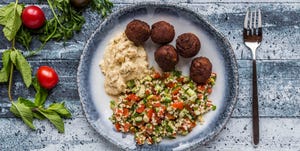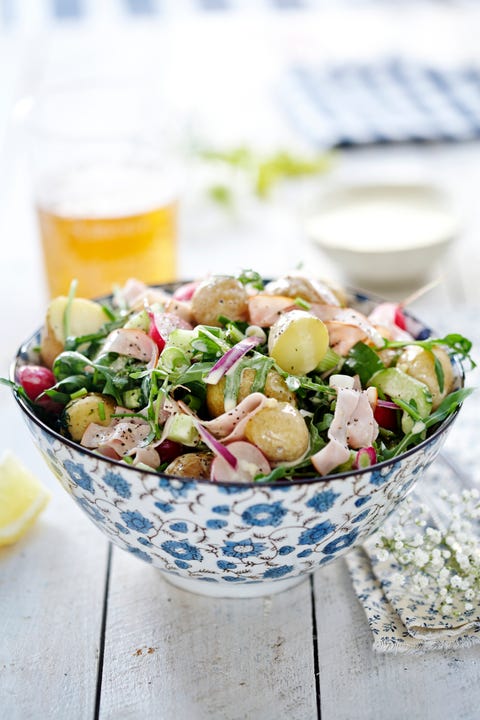If you love keeping up with the latest food trends, you may have heard the term “resistant starch” buzzing. While research is still in early days, resistant starch has been linked to some legit health benefits. The best part? It’s found in foods you’re probably already eating (carbs!).
Never heard of resistant starch before? Here’s the deal: “Resistant starch is a type of fiber found in some starchy foods,” says Mindy Patterson, PhD, a nutrition researcher and assistant professor of nutrition at Texas Women’s University. While most starch gets broken down into glucose, resistant starch, well, resists digestion and can’t be broken down. Intrigued? There’s so much more to know about resistant starch.
It could keep your gut healthy.
Studies have shown that increased resistant starch intake may lead to a more diverse (a.k.a. healthier) gut microbiome. That’s because resistant starch foods contain prebiotic fibers which “ferment in your colon and feed the good bacteria in your gut,” Patterson explains. (For a refresher, prebiotics are food for probiotics, the good bacteria in your gut.)
Resistant starch may have long-term health benefits.



So far, the research on resistant starch is promising. In addition to promoting a healthy gut, it’s been shown to increase insulin sensitivity, boost digestive health, and improve blood sugar control.
To reap these benefits, Patterson recommends including a serving of one of the foods below in at least two meals per day. She also points out that these benefits are linked to long-term, regular consumption of resistant starch—you can’t just eat a serving of cold potatoes and expect magic to happen.
Cooking and temperature matter.
Speaking of cold potatoes, how you cook your resistant starch foods matters. That’s because heat can affect the structure of starch molecules. For example, “when you cook a potato, heat opens up the starch granule and makes it more accessible to our digestive enzymes,” Patterson says. When this happens, the starch enters the bloodstream as glucose—a.k.a. sugar.
On the other hand, “when you cook a potato and then chill it, that starch granule closes up,” she says. “Since it can’t be broken down by enzymes, it doesn’t enter the bloodstream as glucose, it enters the colon and can be fermented by bacteria.” In other words, that’s how it becomes a prebiotic.
That said, it varies from food to food. (Check out our prep tips for each food in the list below.)
Want to learn more about healthy eating? Here’s what Biggest Loser chef Devin Alexander eats in a day:
Want to add more to your diet? Try these resistant starch foods:

Johner ImagesGetty Images
1. Cooked, chilled potatoes
The starch in hot potatoes is easy to break down, so you’ll need to eat your cooked potatoes cold in order to get resistant starch. To make this palatable, Patterson suggests serving them in a potato salad. (Because, plain cold potatoes? Hard pass.)

Claudia TotirGetty Images
2. Beans and legumes
Good news for those who like their food hot: Serving beans and legumes hot maximizes their resistant starch content, says Patterson, although they still contain resistant starch while cold. So, you’ll get a little bit of resistant starch from hummus and bean salad, but more from warm dishes like chili or chana masala.

shakzuGetty Images
3. Green (or just ripe) bananas
As bananas ripen, much of the starch gets converted to sugar (that’s why they’re sweetest when they’re super ripe and brown). So, unripe green bananas are starchy, and much of this is resistant starch. Eating less-sweet bananas may take some getting used to, but try slicing one over slightly sweet cereal, or a yogurt parfait.

Natthakan Jommanee / EyeEmGetty Images
4. Green plantains
Patterson also recommends green plantains as a good source of resistant starch. Similar to bananas, they contain resistant starch molecules that haven’t yet been converted to sugar. Cook your plantains and chill them before eating, to get the most resistant starch.

Westend61Getty Images
5. Reheated rice
As with potatoes, the starch in rice is converted to resistant starch as it cools. Because cold leftover rice sounds terrible, Patterson points out that reheated rice, specifically fried rice, is still high in resistant starch.

Westend61Getty Images
6. Jerusalem artichokes (a.k.a. sunchokes)
Jerusalem artichokes—which actually have no relation to green artichokes—are a member of the sunflower family, sometimes called sunchokes. They’re nutty and sweet when raw, but taste potato-y when baked. Serve them chilled to maximize resistant starch, maybe atop a colorful salad.

FloortjeGetty Images
7. Corn tortillas
“The longer you store a corn tortilla at room temperature, the more resistant starch is going to form,” Patterson says. You can reheat the tortilla to eat it, but letting it sit on the counter for a few days beforehand will increase the resistant starch content.

Vesna Jovanovic / EyeEmGetty Images
8. Oats
While cooked and cooled oats pack the most resistant starch, you can still get quite a bit from a warm bowl of just-cooked oats. If you’re already eating oatmeal for breakfast, keep it up! If not, consider swapping it in for your regular breakfast a few times a week.

haoliangGetty Images
9. Barley
While several cooked whole grains contain resistant starch, Patterson calls out barley as a particularly good source. Because it doesn’t dry out as much as some other grains when cooked and chilled, barley is also a great candidate for cold grain salads.
Source: Read Full Article
